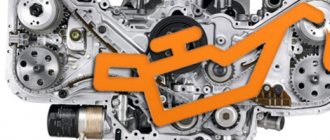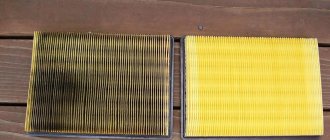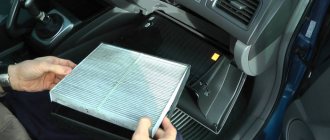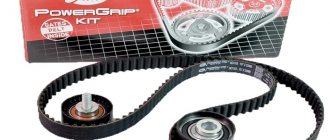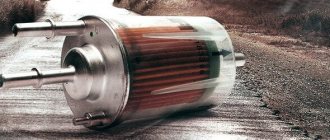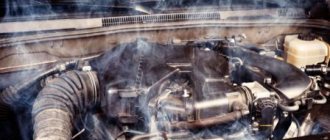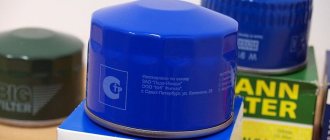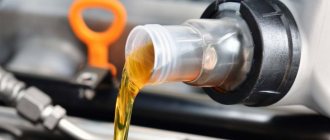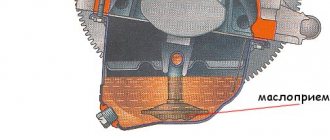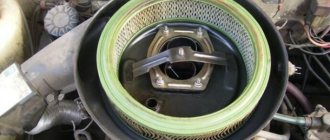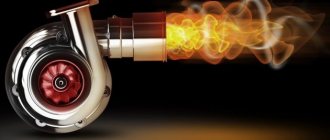Oil filters are one of the most important elements of car maintenance, because motor oil is the “lifeblood” of your vehicle’s engine. Its main purpose is to lubricate the working elements of the engine and remove or stop contaminants through the oil filter. The oil filter, together with the engine oil, work to protect the engine from the entry of polluting particles that can harm the engine and turbocharger, including causing them to fail.
Oil filter elements
- Housing
, which serves to protect the filter elements. - Oil inlet and outlet holes
;
a threaded hole
in the center with which the filter is attached to the engine. - Anti-drainage valve with rubber cover
; it prevents oil from pouring back into the filter when the engine is turned off. - The spring
, together with the anti-drainage valve, prevents oil from pouring into the filter when the engine is not running. - Filter media
, which can be made from synthetic materials, cellulose fibers, polyester or glass. Responsible for cleansing the oil, retaining mechanical impurities. -
steel tube - Safety valve
, which is located on the reverse side opposite the threaded hole. The valve serves to stabilize the pressure. - The filter cover
and
o-ring
are responsible for the tightness of the equipment.
How does an oil filter work?
Before entering the engine, the oil passes through the oil filter. The oil pump supplies oil to the filter, where the crude lubricant passes through the filter element, which traps contaminants. The filter contains primary and secondary media types. The primary ones trap large particles, the secondary ones – small ones (from 5 microns in size). After filtration, the oil is pushed through the central hole into the engine. Over time, more and more contaminants remain on the filter element, so it is fundamentally important to regularly replace the filter.
Why does the oil filter fail?
The filter element becomes clogged with mechanical impurities;
Untimely oil change;
Incorrect selection of engine oil, both for the engine and for the oil filter.
What are the symptoms of a faulty filter?
- Oil leaking from the filter or filter housing.
- Engine overheating.
- The emergency oil pressure lamp does not go out for more than 5 seconds. But it is difficult to identify a malfunction based on this sign, since the lamp can turn off even if the filter is faulty. This happens because when the filter is dirty, the oil can flow through the bypass channel, which allows the oil to circulate without entering the filter. This prevents the engine from starving of oil.
What are the consequences of a malfunction?
- Faulty filters no longer retain mechanical contaminants; accordingly, dirt and harmful impurities enter the engine and turbocharger.
- A malfunctioning filter can cause damage to the engine walls and pistons, causing oil and fumes to escape through the exhaust pipe.
- And finally, a malfunctioning oil filter reduces the vehicle's mileage without damage.
Washing a clogged filter, is it worth doing?
Car enthusiasts in the eighties often washed clogged oil filters using kerosene or gasoline. It is worth noting that the filters then were collapsible and quite large. There were also often problems with purchasing consumables, so car enthusiasts had to do the washing. Nowadays, few people do filter washing, filters are inexpensive, and the labor-intensive process does not give a 100% result. If you decide to wash the filter, most likely you have an exclusive car, for which consumables are incredibly expensive or simply do not exist.
The washing process begins with removing the filter, for which a special puller key is used. Kerosene is poured into the filter, but it is better to use kitchen cleaners to remove stubborn dirt. After an hour, the filter should be shaken thoroughly and rinsed with strong water pressure. This soaking and rinsing procedure should be repeated several times.
After all washings, it is recommended to blow out the filter with a strong stream of compressed air. As a result, you will either receive a filter that is 80 percent cleaned, or the filter element will not withstand the aggressive effects of chemicals and will fall apart. It is not a fact that after cleaning the filter will perform its functions well.
Oil filter in turbocharger operation
We all know that oil plays a key role in the long-term operation of a turbocharger, and often it is oil (oil contamination, untimely replacement, etc.) that causes turbocharger failure. Dirty oil kills the turbocharger, it affects the turbine much more than any other part of the diesel engine. Under extreme loads, the rotation speed of the turbine shaft can be 250 rpm, and at this time, engine oil is the only thing that cools the turbine, gives it lubrication and prevents metal parts from rubbing against each other. That's why it's vital to keep your oil clean and your oil filter in good working order—the best protection for your turbocharger and engine. The turbocharger has to work under difficult conditions: at high speeds and at high temperatures, and clean filtered oil will protect the turbine from wear.
As mentioned above, a lot of contaminants remain on the filter element that the system cannot remove on its own, so do not forget to check the cleanliness of the filter from time to time and change it if necessary. An oil filter will extend the life of your turbocharger and engine.
22.06.2018
Malfunctions of the oil pump will inevitably lead to disruptions in the lubrication system of the internal combustion engine. serves to ensure pressure in the oil supply system. Symptoms of malfunctions and interruptions in the operation of the device indicate serious problems that require immediate attention.
What filter?
The engine design requires the use of an oil filter of a certain type and size. Most of the spare parts, especially consumables, are standardized. A filter for your car may be installed on cars from another manufacturer, but it will cost several times less and may not require ordering this part. In order to determine the actually suitable filter, you need to refer to the catalogs of filter element manufacturers.
The use of high-capacity filters, instead of standard ones, is permissible only in cases where it is possible to provide access for filter replacement and, in some cases, if the bottom of the filter housing does not protrude beyond the lower limit of the engine protection. And it is mandatory when operating in dusty environments and using mineral water.
Main signs of a malfunctioning oil pump
The vehicle's lubrication system ensures stable and durable operation of the main engine components. The engine contains many parts that experience strong friction during operation and quickly wear out without constant lubrication.
Many motorists are interested in the question - how to recognize a faulty oil pump? If the oil supply is insufficient, a so-called “oil starvation” occurs. It can lead to engine failure, resulting in a complex and expensive overhaul of the power unit.
One of the first signs that the oil pump is damaged will be a light on the instrument panel. If this happens, you should check the pressure in the oil supply system, and also pay attention to the oil consumption.
- Reduced oil pressure in the system.
- Noticeable increase in oil consumption.
If the pressure in the device decreases, the car cannot be used until the cause of the problem is determined and the car is repaired.
There are several main reasons for system malfunctions. Here are some of them.
How to determine oil starvation
It was immediately clear that the engine was “starved of oil”
First, let's talk about determining engine oil starvation, since the range of symptoms is quite wide - from a drop in engine power to overheating, extraneous noise and knocking. All this indicates wear of certain components characteristic of each engine. For example, in the most common overhead gasoline engines, accelerated wear and increased noise during operation of the gas distribution mechanism are often encountered.
Consequences
The consequences can be very different - jamming of the camshaft, bending of the camshaft, bending of the valves, destruction of the rocker arms, cranking of the crankshaft liners, jamming of the rings in the liner until the destruction of the pistons.
In addition, the oil scraper rings may become stuck, which will lead to even greater excess oil consumption and engine seizure. Thick blue smoke from the exhaust pipe will indicate a malfunction of the oil scraper rings and high oil consumption.
Causes of oil pump failure
- drop in oil level in the engine crankcase;
- damage to pressure monitoring devices;
- use of low-quality oil;
- using the wrong oil for the vehicle;
- failure of lubrication or safety valves;
- oil filter contamination;
- clogged oil receiver and blockage in the pump housing.
The blockage may be due to a dirty engine crankcase. To eliminate this problem, it is enough to remove the crankcase (after draining the oil) and clean the pan of dirt.
Malfunctions in the oil pump can manifest themselves in the form of various problems. They can be determined during diagnostics. The main possible problems with the mechanism are listed below.
Oil pump malfunctions:
- gasket damage;
- oil filter clogged;
- the filter is not secured securely;
- increased wear of main parts;
- failure of the pressure reducing valve.
The oil pump in a car has a fairly long service life and breaks down infrequently. Most often, breakdowns are caused by improper operation of the car engine, poor-quality repairs or the use of low-quality oil. A decrease in oil pressure and an increase in its consumption are the main signs of a malfunction of the oil pump, after detection of which the system should be immediately diagnosed and the cause of the failure eliminated.
Externally, the oil filter looks as simple as the task assigned to it. And this task is simpler than a steamed turnip: to clean from dirt, which is a set of foreign inclusions that have penetrated into the engine from the outside along with air and fuel, wear products of rubbing engine parts, as well as soot, coke, and mucus-like oil decomposition products formed inside the engine.
Nothing else is required from the filter, so if you look into it through the threaded hole in the bottom, you can expect to see a paper filter element inside that traps dirt that appears in the oil. The better the dirt is filtered out, the longer the engine will last until it eventually becomes a victim of natural wear and tear.
However, if you disassemble the filter into individual components, it turns out that in addition to the filter element, there are some other parts in it.
This is a bypass valve. It owes its appearance in the filter design to the fact that as dirt accumulates in the filter element, the resistance to oil flow through the oil filter increases. Because of this, situations are possible when the filter actually turns into a plug, preventing the flow of oil to the rubbing parts. The bypass valve is precisely designed to prevent oil starvation in the bearings of the crankshaft, camshaft, and turbocharger cartridge, which are lubricated under high pressure, and their subsequent jamming.
As soon as the filter's resistance to oil flow becomes excessive, the valve opens, after which the oil flows past the filter element to the parts lubricated under pressure. However, another problem arises - the oil is supplied unrefined. To put it simply, the lubrication system begins to work as if there was no filter at all, with all the ensuing consequences for the service life of the engine. The question arises: when does the bypass valve actually open? This question was asked by our reader who sent a letter to the editor of the site, excerpts from which we present below:
“I came to the conclusion that in order to detect the moment the bypass valve is activated, you can use a button with normally closed contacts and a control light. We connect one contact of the button to the filter housing, and take the other out. When the valve is closed, it presses the button. The contacts are open - the light does not light. But when the valve opens, the button is pressed and the light comes on.
Prepared the filter. The button was soldered into double-sided PCB. I drilled a hole into which I inserted a textolite insert with a button. It took some time to adjust the height of the button. While I was adjusting it, the engine oil, according to the indicator on the instrument panel, managed to warm up to 50 degrees. With such warming up, the control light signaled that the bypass valve was activated only at 6000 rpm and immediately went out. When the engine warmed up completely, the light did not come on at all.
The next morning I returned to the car. The alcohol thermometer on the wall in the garage showed 2 degrees below zero. I started the engine and the light didn’t even blink. I add speed to 2500 - there it is, it lights up! I drop the revs to 2000 and it goes out. So, everything works as it should! It remains to be seen how long the filter will last.
The first results appeared after a run of 1000 km. I attached a temperature sensor from a multimeter to the filter with electrical tape. The filter temperature is 4 degrees below zero. Exactly the same amount was on the thermometer in the garage. I start it up and the light comes on immediately. This is understandable: the oil is thick in the cold, the filter is already slightly clogged with dirt. He has no choice but to open the valve and let the dirty oil in directly. I wait and watch the multimeter. The oil temperature has already reached 15 degrees Celsius, and the light still does not go out!
Maybe the valve is stuck? I turn off the engine and the light goes out. I start it up and it lights up. So everything works. Only at an oil temperature of plus 30 did the light go out at idle. At the same time, the coolant temperature has already risen to plus 55. I increase the speed to 2500 - the light comes on, slowly drop it to 1300 - it goes out. I didn't wait any longer. But there is already something to compare: with the new oil and filter it was the same, only then it was minus 2, and now the same result at plus 30. In any case, after complete warming up in normal mode, the valve does not open, which means the oil filtered. What else do you need?
Subsequently, the situation only worsened. At 2500 km, when starting, the light comes on and does not go out at all. If, after a good warm-up, you turn it off, and the bypass valve naturally closes, and then start it, the light does not light up. I give the rpms under 3000 - it lights up and doesn’t go out again. This means that the valve is not closed and allows unrefined oil into the engine lubrication system.
In addition to experiments on my personal car, I soldered the same buttons into the filters of my friends’ cars. That is, the operation of the bypass valve and how long the oil filter does its job have been tested on different machines, with different oils and different filters. The result is the same: 2500 km is the ceiling for the filter. Once, however, they reached 3000 km. Maybe the fact that the car made a couple of long-distance flights played a role.
I would also like to say a few words about the check valve. It is supposedly designed to prevent oil from leaking out of the filter when the engine is turned off. The idea is good, but only this valve holds the oil, which is in the outer circuit, and for some reason the manufacturers do not take into account the fact that it can simply seep through the paper and drain through the inner tube! How long it will take for this to happen is hard to say, but it must flow out! The best option is when the filter is installed bottom up, such a filter does not need a check valve at all. In other cases, only frequent starting or a clogged filter can help, when dirt does not allow oil to seep through the paper. If this is not the case, in the morning we start our cars with empty filters.”
From the editor
The recommended frequency of replacing engine oil and oil filter in Belarusian operating conditions is 12-15 thousand km for gasoline engines, 8-10 thousand km for diesel engines. Judging by the results of the experiment carried out by our reader, only the first 2.5-3 thousand km after replacement does the filter cope with its duties of cleaning the oil from dirt, and then it becomes less and less useful, if it remains at all.
Choose motor oil for your car from!
A puddle of oil under the car will make any driver worry. Every time I go out and have a free minute, I try to warm up the engine at the garage and only then move. An oil leak in the area of the oil filter is a serious thing, even if you have complete confidence in the serviceability of the oil pump and filter, it is worth delving deeper into the problem. It's not even about what squeezed the oil through the oil filter. It squeezed out - that's understandable. The problem is why, for what reasons, high pressure occurs, which squeezes the oil out from under the oil filter.
In most cases, the problem is solved by tightening the filter housing more firmly, sometimes even using improvised tools. Most knowledgeable motorists consider the following to be the culprits of the incident:
- incorrectly selected lubricant viscosity;
- malfunction of the pressure reducing or bypass valve;
- low-quality product with a weak and soft body;
- loosely twisted oil filter housing on the fitting;
- Poor quality o-ring rubber seal.
Petrovich35 › Blog › Territory of misconceptions, or myths about oil filters.
There is such a program on the Russian TV channel RenTV, called “Territory of Delusions.” So, talking in the comments to my previous post about the size of oil filters (see High technology or savings?
), I was surprised to discover that despite the simplest design of the oil filter, an excellent story could be made on this topic for the said program. Well, or, at least, for the well-known “Myth Busters” from the Discovery Channel.
The background to the question that prompted me to start writing this article. I will give fragments of two dialogues from correspondence in the comments between me and my colleagues at drive2. I do not present the text of the correspondence in full, but only to highlight the main essence.
Colleague1:
About the oil filter: - what is the oil pressure in the system and at what engine speed?
— what is the opening pressure of the bypass valve in the filter? — what time (in%) does the oil pass through the filter? - What does the filter filter in the oil? Having answered the questions correctly, it will become clearer why the filter is small :
A hint that the valve is almost always open?
Colleague1:
“is the valve almost always open?”
Right. Depending on engine fatigue, the valve is open from XX... I:
On oil forums they write that it is not the pressure in the system that plays a role, but the pressure drop in the filter.
Colleague1:
Cut the filter, inspect the filter element.
Pressure at 3000 rpm from 2.4 to 5.3 kg/cm! Think about a volumetric oil supply at 3000 rpm of about 30 l.min. Look again at the filter element “pressure drop in the filter” - how is that? Colleague1 (a little later):
As an option: oil is constantly pumped through the filter.
And the valve does not cut off completely, but redirects that part of the oil that it cannot pass through itself, bypassing it. At this point I stopped further discussion and suggested returning to it in a separate article.
Colleague2:
The only difference is the quality of the filter element.
Size matters too - purely in terms of design dimensions. For example, for ease of maintenance (a large filter may not fit into a narrow space). But moving away from the standard to a larger one can generally be disastrous for the engine. I:
Everything is clear with quality. How can a filter larger than the original one harm the engine? What is the main harm?
Colleague2:
The oil won’t be filtered, that’s all.
There is a valve there. Look inside the filter. I:
Please explain in a little more detail why the oil will not be filtered in a larger filter than the standard one and how the valve affects this. I present the filter design because I periodically cut up used filters of different brands.
Colleague2:
Cutting apart filters and not learning how they work))) is funny!
Did you change the filter yourself? When you removed the filter from the engine, did you see the tube? Which sticks out from the opening of the oil filter well. The hole in this tube is an oil channel. Why do you need to turn the filter to a certain stop and a little back? In order for the channel to open the valve and oil flows through the filter material. And the valve may sit closer or deeper from the base of the filter. Let's imagine a situation: you install a large filter and a valve deep... What will happen? Right! Oil will enter the oil filter housing, but will not pass through the filter element! At this point I also stopped further discussion.
Colleague3 (joined the discussion):
Dubious version.
I also sawed a lot of filters. I have never seen a valve being opened by a tube. This is also the first time I’ve seen something about “all the way and a little back.” Colleague2:
Petrovich and I discussed this issue yesterday.
They agreed that he would carefully study and write a detailed article. I did make some mistakes with the function of the valve, but nevertheless, it was designed there for a reason. As for tightening the filter, it’s like “ZHI-SHI” for a first-grader. Screw the filter all the way and 3/4 turn back. It is described in any manual for beginners. If you noticed, I deliberately did not argue and defend my point of view with foam at the mouth, thereby provoking the so-called “srach”. But I think that for many readers, from the above dialogues it became clear that there is a real need to understand how the oil filter works and how it works, as well as how to install it correctly.
In order not to turn the article into a stream of chaotic thoughts, let's structure the problem and highlight the key issues that we need to consider. I saw two serious misconceptions in the comments:
Misconception 1:
The bypass valve in the oil filter is open at any engine speed slightly above idle speed (1500+ rpm), so the size of the filter element is not so important, since most of the time the oil bypasses and is not filtered.
Misconception 2:
A threaded pipe located on the engine, when tightening the filter, presses on a certain valve in the filter, and the valve opens the oil channel for oil to enter the engine. Therefore, the filter should not be larger than the standard one so that the pipe can reach the valve. For the same reason, after screwing in, the filter should be unscrewed back 3/4 of a turn, otherwise the valve will not open.
If a misconception about what happens inside the filter during engine operation, in principle, does not threaten anything fatal, then incorrect installation of the filter, and even caused by a misconception about its design, can lead to loss of oil and engine failure.
Therefore, today we will consider the following questions:
Question 1:
How a typical non-separable automobile oil filter is designed, what functions the individual filter elements perform.
Question 2:
Under what conditions does the bypass valve in the oil filter open and what is the importance of this valve.
Question 3:
How to properly install and tighten the oil filter.
I immediately warn the irreconcilable fighters against “couch experts” that I am not a hydraulic specialist, I do not pretend to be an expert on filters, and I consider these issues as an ordinary practicing car enthusiast with a technical education. I do not present my thoughts as “a ray of light in a dark kingdom,” but I only want to understand this issue in more detail and share this information with fellow car enthusiasts.
Surely among the readers there are people who are much more professional in this topic, I ask them to also speak out, correct me if I’m wrong in something, and participate in the general discussion. I will approach my explanations simply, in a worker-peasant way, from the point of view of simple everyday logic. I also apologize to the experts if I use the wrong terminology.
1. Oil filter device.
All modern non-separable oil filters have approximately the same design, which is shown in Fig. 3 below.
Filter elements from different manufacturers and brands of cars may differ slightly both in design and in their location in the filter housing, but their composition and operating principle are absolutely the same in almost all cases.
The design of such a filter is very simple: oil flows from the engine into the filter through several holes located around the circumference of the filter cover, then passes through the filter element and, already cleaned, returns to the engine through the central threaded hole. The filter also has two valves - anti-drainage and bypass; we will look at their operation in detail a little later.
For illustration, below are photos of oil filters cut to examine their insides. I open used filters myself, but for this post many photos of filters were taken from the site oilchoice.ru
, with the permission of the site administrator
GubkinS
. This site presents more than a dozen sawn filters with high-quality photographs, so I decided to borrow them from there. To best illustrate a particular filter element, I selected photographs of different filters, rather than just one.
Having opened the oil filter, we see that the filter housing consists of a thin-walled metal cup, which is closed on top with a rolled thick-walled metal lid. There are several holes around the perimeter of the cover through which unrefined oil enters the filter. The central threaded hole serves to allow cleaned oil to exit the filter and at the same time to attach the filter to the engine. The filter is screwed to a threaded pipe located on the engine. On the outside of the cover there is a rubber sealing ring of a rectangular, round or semicircular profile, which ensures a tight connection between the filter and the engine (photo 4).
The main volume of the filter is occupied by the filter coil. In most cases, the coil consists of an internal cage made of perforated metal sheet with holes for the passage of oil, around which the filter material is located (photo 5). As a rule, the reel has top and bottom metal covers, although designs without covers are also available.
Filter paper is often used as a filter material, but non-woven fibrous material is sometimes used. To increase the filtration area, filter paper is laid in corrugations. The corrugations are usually even, but some companies, to increase the filtration area, additionally lay the paper in a chevron pattern, as, for example, in Purflux filters.
To prevent the coil from dangling inside the filter, a spring is usually pressed from below. Springs are used both spiral and leaf. Sometimes there is no spring, and its role is played by an elastic anti-drainage valve.
Also, most oil filters have two valves in their design.
The oil inlets in the filter cover are closed from the inside with an anti-drainage valve
. This valve is visible during external inspection of the filter. Usually it is an elastic ring made of ordinary or silicone rubber, although more complex designs using springs are also found.
Regardless of the design, the anti-drain valve performs two main functions.
First, unless the filter is positioned perfectly vertical with the holes facing up, this valve prevents oil from draining from the filter into the engine sump when the engine is stopped.
Thanks to this, the engine does not experience oil starvation due to an empty filter during startup after a long stop.
When oil is supplied from outside, under the influence of oil flow, the valve bends and lets oil in, but it should not let oil back in, even if the filter is located with the holes facing down.
The second function of the anti-drain valve is to prevent the flow of oil from the cavity with dirty oil (on the outside of the filter coil) into the cavity with clean oil (inside the central race).
Those. the valve seals the filter cover from the inside and isolates the central outlet from the peripheral inlets.
So, in order for a drain valve to be leak-tight and maintain that seal over a wide range of temperatures, the material of the valve, its temperature properties and elasticity, as well as how carefully it is made, are important. According to my own observations, valves made of silicone rubber work best at different temperatures; they do not care about frost or hot oil. The valves in filters from well-known companies are made most carefully. Cheap filters rarely boast of both; the valves in them are usually made unsightly and from ordinary rubber. Therefore, if we want to save money, it is better to do this in the warm season, since in the cold the rubber valve hardens. There are generally filters without valves; it is better to avoid them.
The second valve is a bypass valve.
It is usually located on the other side of the coil, although there are also filters with valves located on one side, but this is rather rare.
The bypass valve allows oil to bypass the filter media directly into the engine without purification.
When the valve opens, the oil passes directly to the outlet of the filter.
Therefore, it is sometimes also called bypass
, from the English word
bypass
(bypass). Below we will return to a more detailed consideration of the operating principle of this valve.
Structurally, the bypass valve is a spring-loaded plate that covers the hole in the end of the coil. The pressure at which the valve opens depends on the stiffness of the spring. The plate material can be metal, plastic, rubber. The main requirements for the valve are that it operates smoothly, without jamming, and that it reliably seals the hole in the reel cover.
Typically, the bypass valve is located on the inside of the coil cover, but there are also designs with an external valve location, as well as when the valve is built into a leaf spring that presses the coil. The photo below shows bypass valves of various designs. Sometimes there are filters in which the manufacturer saves money and does not install a bypass valve.
2. The operating principle of the bypass valve and the conditions under which it opens.
As noted above, the bypass valve opens only when certain conditions occur. Most of the time the engine is running, it is closed, since when it is opened, the filter ceases to perform its filtering functions and simply transfers unclean oil to the engine, bypassing the filter element.
The filter operation in filtration mode and operation in bypass mode are shown in Figures 14 and 15 below.
Legend in Fig. 14: 1 - filter housing. 2 — rubber gasket on the filter cover. 3 - anti-drainage valve. 4 - filter coil. 5 - bypass valve.
Now let's return to the erroneous belief that the bypass valve is almost always open when the engine is running.
This misconception arises due to the fact that in most filters the bypass valves are designed for an opening pressure that rarely exceeds 2.5 bar, and more often in the range of 0.8-1.5 bar. For example, in the MANN W820 oil filter, the valve is designed for an opening pressure of 1.0 bar.
At the same time, the oil pump, when the engine is operating in normal modes, pumps up much higher pressure in the oil system, in the range of 2.5-5.5 bar (the numbers are approximate and vary for different types and brands of engines). Based on these figures, some car owners conclude that since the pressure in the oil system is constantly higher than the opening pressure of the bypass valve, it means that it is open most of the time.
This is the main misconception, and let's show with simple examples that this is not so.
To understand how the valve will behave, we first consider two boundary situations.
Since we have already examined the structure of the oil filter, we will imagine that everything in it remains as it was, but we have removed the filter material.
That is, the coil now has only a metal frame and does not provide any resistance to the flow of liquid; the hydraulic resistance of the coil is zero. How will the oil flow in this case? I think even a person far from technology will understand that the liquid (oil) will move along the path of least resistance
.
That is, if the coil does not offer any resistance to the flow of liquid, then at any, even the highest absolute pressure in the lubrication system, the oil will flow through the coil, bypassing the bypass valve
. Because a certain force (pressure) is required to open the valve, but no force is required to pass through the bare coil, and as a result, the oil will flow through the filter in a direct flow. In this case, the oil flows will be directed through the coil, as shown in Fig. 14.
Now let's look at another boundary situation that is completely opposite.
Let's imagine that we replaced the filter paper with a metal tape.
That is, we welded the coil tightly, and now it does not allow oil to pass through at all, the hydraulic resistance of the coil is infinity. Where will the oil flow go in this case? That's right, along the path of least resistance, that is, through the bypass valve.
In this case, if the oil pressure at the filter inlet exceeds the valve opening pressure, the oil will flow through the valve, overcoming the resistance of the valve spring. In this case, oil will flow into the engine, albeit unrefined.
That is, the bypass valve acts as a “savior” of the engine from oil starvation if for some reason the filter coil stops passing oil. If the valve is designed for a pressure exceeding the capabilities of the oil pump, then in this case the oil filter will under no circumstances allow oil to pass through itself and will essentially turn into a plug that will leave the engine without oil. That is why it is important that the valve opens at a certain pressure, since its correct operation will determine when purified oil will enter the engine, and when uncleaned, and whether the filter will turn into a plug that is detrimental to the engine.
This situation is illustrated in Fig. 15.
From the examples discussed above, we saw that in order to open the bypass valve, it is not important what pressure the oil pump develops, but whether the filter coil has time to pass oil through itself so that the valve does not open prematurely. That is, the valve opens not from the absolute pressure in the system developed by the oil pump, but from the pressure difference at the inlet to and outlet of the filter.
If the coil begins to pass oil worse as it gets dirty, then its hydraulic resistance will increase, and the pressure difference at the inlet and outlet of the coil will correspondingly increase, as a result, at a certain point in time the bypass valve will open. This situation can also occur if the oil has a high viscosity and does not have time to be pumped through the filter material quickly enough, for example, during a cold start of the engine in frosty weather. In this case, the valve opens and the thick oil enters the engine directly, unrefined. As soon as the oil warms up, its viscosity decreases and the coil begins to pass oil normally, the bypass valve will close, since it is no longer needed.
Likewise, if the engine suddenly picks up speed, for example, when you sharply press the accelerator, then the pressure in the oil system will increase sharply, and in these transient conditions the filter material may not be able to cope with pumping the sharply increased volume of oil, then in this case the bypass valve will also open and thereby provide the engine with oil.
In all other cases, the valve remains closed at any absolute pressure in the oil system, since the oil follows the path of least resistance, that is, through the filter material.
To summarize, the bypass valve only operates under a limited number of conditions. It does not allow the engine to be left without oil when the filter element is clogged with wear products, as well as when the oil is thick and poorly pumped through the filter element (for example, in cold weather), or in transient operating conditions of the engine (for example, during a sharp increase in speed). In these cases, the bypass valve opens and crude oil enters the engine, bypassing the filter material. As they say, it is better to feed the engine with unrefined oil than to leave the engine without any oil at all. Therefore, an important parameter is the pressure drop at which the bypass valve opens. The valve should not open too early for the filter to perform its filtering function, and should not open too late so as not to leave the engine without oil.
There is an interesting article on the network, “ABW.BY reader experiment: does the oil filter only last 2500 kilometers?”
www.abw.by/novosti/experience/183246/, after which I decided to change filters more often. First of all, this applies to cheap filters in which the manufacturer saves on everything. Therefore, for myself, I decided to change the oil filter every 5 tkm, especially under severe operating conditions, and avoid cheap filters with a short lifespan.
So, we have figured out the structure and operating principle of the oil filter. As you can see, there is nothing complicated in the design of the filter; it consists of only a few parts, and the principle of its operation is also very simple.
3. Correct installation of the oil filter.
Source
In pursuit of engine life
Before making a diagnosis as to why the lubricant was squeezed out, it is worth correctly assessing the conditions under which the problem occurred. Let's take into account the temperature and quality of materials. We will not consider the fourth position; in this case, the oil leak from under the oil filter was the result of inexperience rather than dishonesty. You only need to tighten it by hand, making sure to lubricate the sealing gasket with oil. If you tighten the filter using a tool - a wrench or a special puller, the rubber may be deformed too much, and the edge of the filter cover will come into contact with the mounting flange. In this case, the tightness of the connection will remain in question and the lubricant can be squeezed out at any time.
The first typical mistake that causes oil to squeeze out through the oil filter is high speed in cold weather. Ordinary mineral oil thickens at low temperatures to the state of jelly or grease. A gear pump can raise oil pressure up to 10 bar and squeeze it out through any gap, but it’s difficult through a microsponge or filter paper, and the cold oil flow is very reluctant to pass through the bypass valve.
Often such experiments lead not only to the lubricant being squeezed out from under the oil filter, but also to damage to the hardened seals on the crankshaft. In the latter case, repairs will cost several times more than a conventional device replacement.
Advice! If you often drive in severe frosts, switch to 0W20 viscosity oil and an oil filter with a spring bypass mechanism. The rubber flapper valve works much worse in severe frost. Also, be sure to check the operation of the spring valve before installation. Often the reason that grease is squeezed onto the road is a jammed valve.
If the filter element is designed for light, low-viscosity synthetic oil, then its design will have a reduced number of inlet holes, and they will be of smaller diameter. Due to the high viscosity of cold mineral water, the main flow of oil is not able to be squeezed out through small holes. As a result, the housing was swollen or the oil filter gasket was pressed out.
The second, most common mistake is the inappropriate use of various types of revilitants that offer quick restoration of rubbing surfaces. In most cases, all the debris added to the oil ends up in the filter element and bypass valve, blocking the flow and, as a result, forcing the lubricant through the seal.
Do not use traditional recipes for flushing the lubrication system - mixtures of kerosene and oil, gasoline and oil, kerosene with acetone and benzene. At best, such an explosive mixture will dissolve sediment in the drain channels and in the engine sump. Attempts to start the engine and idle result in light and low-viscosity fluid leaking and squeezing out through the oil seals and the housing seal. Residues from such flushing can lead to swelling and deformation of all gaskets in the lubrication system.
A similar effect is possible from high-viscosity motor oil. Advertising for such products promises normal oil pressure for worn engines. In hot weather, this oil actually works better, but with the arrival of cold weather it can easily squeeze out any rubber bands from under the filter. Moreover, oil filters are not designed for such innovations, and as a result, oil leaks from the oil filter.
A situation where the lubricant is squeezed out from under the oil filter results in:
- savings on flushing the oil system with special liquids;
- the bad habit of not changing the oil, but adding it as it decreases;
- use purified surrogates instead of normal high-quality oil.
If flushing was not used when changing the oil, as an option, you can pre-install and use a cheap simple filter. After a hundred kilometers, most of the dirt will be deposited on such a filter, and it will need to be replaced with a new high-quality version. But such a recipe is only allowed when using high-quality oil with good detergent additives.
The habit of adding oil instead of replacing it is typical for owners of old, worn-out engines. The amount of sludge deposits and varnish films compensates for metal wear in rubbing surfaces. In such cases, the filter may leak after a large amount of gasoline and water gets into the engine sump, even in relatively mild frost.
The high cost of good motor oil has led to the emergence of special cleaning technologies that make it possible to clarify used oil, increase its viscosity and remove foreign odors. But even after the cleaning procedure, such a lubricant contains a significant amount of hydrocarbons, which easily turn into varnish films and sludge, tightly clogging the filter cartridge.
Using fake low quality oil filters
The problem of counterfeit products is especially relevant during the winter period of operation or the engine break-in period. First of all, counterfeits use low-quality materials for the filter layer, rubber seal and bypass valve elements.
One of the noticed defects that catches the eye after the oil filter has been squeezed out is a violation of the geometry of the box:
- swollen sides of the body;
- extruding the cover with a threaded bushing “into the dome”;
- deformation and extrusion of the valve rubber.
You can easily determine the quality of the oil filter by blowing into the inlet hole. In a fake, the weak valve petal will easily open; in the original product, it will not be possible to overcome the valve resistance by simply exhaling. In addition, it is worth paying attention to the condition of the filter “accordion” and the rubber ring of the seal.
If the edges of the paper are folded unevenly or are unevenly colored, or metal burrs are visible inside the center core, this is a fake. It is worth paying special attention to the elastic band. The height of the ring above the surface of the lid should not be more than 0.8 mm; the material is quite elastic and rigid, but not hard. Soft rubber will not withstand high pressure - it will instantly deform and be squeezed out of the groove.
A characteristic feature of VAZ cars is the tendency for the pressure relief valve on the engine oil pump to jam. This often happens due to dirt getting into the lubricant or engine overheating. Therefore, if there are repeated episodes of lubricant leakage, do not puzzle over why the oil filter is being squeezed out, but clean and adjust the operation of the pump.
Attention! One of the reasons why oil flows from under the oil filter may be a violation of the perpendicularity of the position of the central fitting onto which the filter is screwed. After installation, the filter housing and cover do not adhere to the flange surface evenly and evenly, but at a barely noticeable angle. In this case, the rubber seal will not provide the necessary tightness, and lubricant will leak under any conditions on any filter. The cause of such a defect may be impacts on the filter housing or excessive force during removal.
Video about what to do if the oil filter gasket is pressed out:
The oil filter plays an important role in the lubrication system. The oil, circulating in the engine vessels, washes away wear products and carbon deposits. The filter, in turn, retains various mechanical particles, allowing clean oil to pass through. Thanks to the operation of the cleaning element, solid dirt components do not slip between the rubbing parts of the engines, which significantly contributes to its long service life.
Oil filter replacement intervals
If you want to keep your engine safe and sound, we advise you to regularly change the oil filter. The oil filter is the main protection of the crankshaft and moving engine parts. If its operation is unstable, the car’s engine quickly fails.
If you have neglected the recommendations for replacing the oil filter for a long time, then be sure that such an amount of dirt has accumulated in it that it hardly passes the oil or, in general, it does not pass at all.
The last assumption is exaggerated, since the design of oil filters provides a bypass valve, which means oil circulation in any case, even when the filter is clogged. But you can imagine what kind of oil it will be. Therefore, do not bring the situation to a critical point.
Various automobile concerns and oil filter manufacturers recommend different intervals for changing cleaning components. As a rule, these periods are very short, since manufacturers care about their reputation and therefore recommend frequent replacement of filters.
Experts advise replacing it every 8-12 thousand km, which coincides with the timing of engine oil changes. However, if you have any doubts about the purity of the oil or any bad signs appear, you can replace the filter ahead of schedule. The benefits of timely replacement are obvious, judge for yourself: if an engine can be purchased from $2000, then a new filter will cost you $10-20. Therefore, do not leave replacing the air filter for later.
Which transmission filter is better to install?
There are a large number of transmission filters on sale, the price range is quite wide, and the quality can also vary greatly. In the selection process, you can easily get confused among this variety. Our recommendations are products from JS Asakashi. Its advantages:
- big choice;
- mechanical strength;
- effective oil purification even from the smallest particles;
- low cost compared to original consumables (with comparable quality).
You can buy JS Asakashi transmission filters (as well as other spare parts, components and consumables) in the SamAuto store. Qualified managers will definitely help you make the right choice and answer all your questions. Contact us, it’s profitable and convenient.
| Manufacturer | Detail number | Part name | Applicability* |
| JS Asakashi | JT318K | Automatic transmission filter JS JT318K | MAZDA DEMIO, MAZDA2, MAZDA3, MAZDA5, MAZDA6, MAZDA WAGON |
| JS Asakashi | JT426K | Automatic transmission filter JS JT426K | TOYOTA AVENSIS, CALDINA, CELICA, COROLLA, FIELDER, HARRIER, NADIA, VISTA, ARDEO; LEXUS RX300 |
| JS Asakashi | JT422K | Automatic transmission filter JS JT422K | TOYOTA ALPHARD, AVALON, AVENSIS, CAMRY, CAMRY/AURION/HV(ARL), CAMRY/HYBRID (ASIA), COROLLA, HARRIER, HIGHLANDER, HIGHLANDER/KLUGER, KLUGER, LEXUS ES240/350, LEXUS ES300/330, LEXUS RX300/ 330/350, LEXUS RX330/350(JPP), LEXUS RX330/350(NAP), MATRIX, RAV4, SIENNA, SOLARA |
| JS Asakashi | JT425K | Automatic transmission filter JS JT425K | TOYOTA ECHO, SCION XA, SCION XB, TOYOTA XA, VIOS/SOLUNA VIOS, YARIS/ECHO |
| JS Asakashi | JT406K | TRANSMISSION FILTER | MITSUBISHI OUTLANDER; Citroen C-CROSSER; Peugeot 4007; Chrysler MK – JEEP COMPASS/ PATRIOT, P3 – DODGE CALIBER (CKD), PM – DODGE CALIBER |
| JS Asakashi | JT411K | Automatic transmission filter JS JT411K | TOYOTA BB, BELTA, COROLLA, COROLLA/ALTIS, COROLLA/FIELDER, FUN, CARGO, IST, PLATZ, PORTE, PROBOX/SUCCEED, VIOS, VITZ, WILL CYPHA, WILL VI, YARIS, YARIS/ECHO, YARIS/VIOS/LIMO |
| JS Asakashi | JT437K | Automatic transmission oil filter | TOYOTA 4RUNNER, FJ CRUISER, FORTUNER, HILUX, HILUX SURF, LAND CRUISER, LAND CRUISER 100, LEXUS GX400/460, LEXUS GX470, LEXUS LX470, SEQUOIA, TACOMA, TUNDRA |
| JS Asakashi | JT208K | Automatic transmission oil filter | MITSUBISHI CHALLENGER, DELICA SPACE GEAR/CARGO, L200, L200 SPORTERO, MONTERO, MONTERO SPORT, NATIVA, NATIVA/PAJ SPORT, PAJERO, PAJERO SPORT, PAJERO/MONTERO, PAJERO/MONTERO LONG, PAJERO/MONTERO SHORT |
| JS Asakashi | JT393K | Automatic transmission filter JS JT393K | TOYOTA AVENSIS, CALDINA, COROLLA, COROLLA/MATRIX (NAP), GAIA, NADIA, NOAH,VOXY, VISTA/VISTA, ARDEO, VOLTZ |
| JS Asakashi | JT319K | Automatic transmission oil filter | NISSAN 100NX, AD/AD EXPERT, ALMERA ALMERA JPN MAKE, ALMERA TINO, ALMERA UK MAKE, AVENIR, BLUEBIRD, BLUEBIRD SYLPHY, CALIFORNIA WINGROAD, CUBE, CUBE CUBIC, D50, EXPERT, GRAND LIVINA PH, GRAND LIVINA VT, INFINITI G20, LANGLEY, LAUREL SPIRIT, LIVINA BRA MAKE, LIVINA C-GEAR, LIVINA GENISS, MARCH, MARCH BOX, MICRA, MICRA C+C, NOTE NOTE UK MAKE, NV200 VANETTE, PRAIRIE PRO, PRESEA, PRIMERA, PRIMERA UK, PRIMERA WAGON, PULSAR, RASHEEN, SENTRA, SENTRA/200SX, SUNNY, SUNNY EGP, MAKE SUNNY(SENTRA), SUNNY/ALMERA, SUNNY/NX COUPE, TIIDA, TIIDA JPN MAKE, TIIDA LATIO, TIIDA MEX MAKE, TIIDA PRC MAKE, TIIDA SEDAN, TINO, TSURU, VERSA, VERSA SEDAN, WINGROAD, WINGROAD / AD |
| JS Asakashi | JT199K | Automatic transmission filter JS JT199K | SUZUKI Kei, MR Wagon, WagonR+ HYUNDAI ATOS, ATOS PRIME, SANTRO; KIA PICANTO |
| JS Asakashi | JT21001K | AUTOMATIC TRANSMISSION FILTER | TOYOTA CAMRY, CAMRY/AURION/HV(ARL), CAMRY/HYBRID (ASIA), HIGHLANDER, LEXUS ES250/350/300H, LEXUS RX270/350/450H, RAV4, SCION TC, SIENNA, VENZA, ZELAS |
| JS Asakashi | JT317K | Automatic transmission filter JS JT317K | MAZDA 323, 626, MAZDA3, MAZDA5, MAZDA6, MAZDA6 WAGON, PREMACY |
| JS Asakashi | JT439K | Automatic transmission filter JS JT439K | TOYOTA CROWN, CROWN/MAJESTA, LEXUS GS/GS, HYBRID, LEXUS GS250/350/450H, LEXUS GS30/35/43/460, LEXUS IS250/300, LEXUS IS250/300H, LEXUS IS250/350, LEXUS IS250/350/ 2##D, LEXUS IS250/350/300H, LEXUS IS250C, LEXUS IS250C/300C, LEXUS IS250C/350C |
| JS Asakashi | JT394K | OIL FILTER Automatic transmission JS JT394K | TOYOTA ALPHARD/VELLFIRE/HV, AVALON, AVENSIS, BLADE, CAMRY, CAMRY/AURION/HV(ARL), CAMRY/HYBRID (ASIA), ESTIMA, LEXUS ES240/350, LEXUS ES250/350/300H, LEXUS ES350, LEXUS RX270 /350/450H, LEXUS RX350, LEXUS RX350/450H, MARK X, PREVIA/TARAGO, RAV4, SIENNA, VENZA, VERSO |
| JS Asakashi | JT325K | AUTOMATIC TRANSMISSION FILTER | MAZDA 323, 323F, MX-3, XEDOS-6; KIA CARENS, MENTOR, SEPHIA, SEPHIA/SHUMA/MENTOR, SMA,GEN, SMA,MES, SPECTRA, SPECTRA/SEPHIA II/SHUMA II/MENTOR II |
| JS Asakashi | JT279K | Automatic transmission filter JS JT279K | KIA PREGIO, PREGIO/BESTA, RETONA, SPORTAGE; TOYOTA CELICA, CHASER, COROLLA LEVIN, CRESSIDA, CRESTA, CROWN, CROWN/CROWN MAJESTA, DYNA 150/TOYOACE G15, DYNA/TOYOACE, ESTIMA, ESTIMA EMINA/LUCIDA, GRANVIA/GRAND HIACE, HIACE, HIACE TRUCK, HIACE VAN,WAGON , HIACE/REGIUSACE, MARK 2, PREVIA, QUICK DELIVERY, REGIUS/TOURING HIACE, SOARER, SPRINTER, TRUENO, SUPRA, TUV |
| JS Asakashi | JT154K | Automatic transmission filter JS JT154K | Ssang Yong ACTYON, ACTYON SPORTS, KORANDO, KYRON, MUSSO, MUSSO SPORTS, REXTON |
| JS Asakashi | JT133K | OIL FILTER Automatic transmission JS JT133K AUDI / VW | AUDI A3/S3; TT Coupe/Roadster; TT/TTS Coupe/Roadster; SEAT Altea, Cordoba/Vario, Ibiza/ST, Toledo; SKODA Fabia, Octavia, Rapid, Roomster; VOLKSWAGEN Beetle, eetle Cabrio |
| JS Asakashi | JT435K | Automatic transmission filter JS JT435K | TOYOTA 4RUNNER, FORTUNER, HILUX, HILUX SURF, INNOVA/KIJANG, INNOVA/KIJANG, INNOVA, LAND CRUISER, LAND CRUISER 100, LEXUS LX470, SEQUOIA, TUV, TACOMA, TUNDRA |
* Please check with our managers over the phone for the applicability of the parts specifically for your car.
Signs of a clogged oil filter
If the oil filter has become unusable, then you most likely will not find out about it until you contact a car mechanic or remove it yourself. It's all about its bypass valve, which was already written about above. If the filter is clogged, it will allow unrefined oil to pass through, which is still better than not having it at all. But not everything is as ambiguous as it might seem at first glance. First, listen to your “horse”.
- Overheat.
When moving engine parts rub against each other without sufficient lubricant, excessive heat is generated. Due to this factor, the engine mechanism begins to wear out faster, which causes additional stress on the cooling system. In addition, unfiltered contaminants form sediment and begin to be deposited in the engine, which causes a decrease in thermal conductivity. The result of this is engine overheating. Normal engine operation takes place at a temperature of no higher than 80-100 ° C; if this indicator is increased, this indicates contamination of the oil filter. - A leak.
A faulty or clogged filter does not respond well to changes in temperature conditions inside the motor. Faulty oil filters can rupture or burst, causing oil to leak. Therefore, if you notice any fluid leaking from your car, contact a mechanic immediately.
The automatic transmission is dying.
My question is this: is this definitely a replacement and it’s obvious that the automatic transmission has died, or is it still possible that it’s not the transmission itself that’s failing, but some kind of control unit?
Symptoms: The oil is black, after a short recent change (it was not a hardware change), the oil burns - it is black again. There even seem to be shavings, the dipstick is a little eaten up. Recently, some kind of additional hum appeared after 3 thousand revolutions (initially it was the fault of the spikes), there are slippages - the revolutions jump sharply, drop sharply, the speed switches. Up to 110 km. the dynamics are good, after 110 the rpm is stable at 3.5, the acceleration dynamics are poor, when you press the gas the rpms can jump up to 5 thousand and the speed creeps up slowly and creeps up. Sometimes it doesn’t shift at all until you release the accelerator and press again.
And one more thing: why do they have such a difference in prices even here? Some for 15 thousand rubles, others for 40. What kind of prices do Japan Parts have in general, 45! Is it worth going for diagnostics? Or is it worth going to buy a box, tell me a good institution with contract wages. Thank you.
Where is the oil filter located?
If you have come to the conclusion that you can handle replacing the oil filter yourself, then before starting the operation you must clearly understand the entire sequence of your actions.
- Find the oil filter. It is located at the bottom of the engine on a sump. (see photo).
- Next, before the replacement procedure itself, drain the oil. It must be drained when the engine is hot, for example, after a trip. If the car is parked for a long time, then start the engine so that it warms up to operating temperature.
- Keep in mind that the brand of oil poured into the engine must be the same as what it was before the replacement. If you decide to change the brand of oil, then flush the lubrication system with flushing oil or oil used subsequently.
- Flushing involves draining the used oil and then filling in new oil to the level of the lower mark. Old oil should not be poured onto the ground; place a previously prepared container. After draining the used oil, start the engine and let it idle for 10 minutes. Next, you can change the oil filter. After replacing it, fill in new oil to the required level - the upper mark on the dipstick.
After this procedure, prepare all the necessary tools and begin replacing the oil filter.
Express oil change
When expressly changing the oil, approximately the same manipulations are carried out. An exception is the process of draining used oil and the process of draining flushing fluid. The draining process is replaced by pumping liquid from the engine crankcase using a special pump.
The percentage of remaining technical fluid, based on the results of opening the crankcase and measuring the volume during a standard shift and an express one, is practically the same.
This technological operation, if performed correctly and in compliance with technical requirements, does not in any way affect the quality of the process itself. It is also necessary to flush the engine before changing the oil using the express method.
Source
Oil filter replacement tools
- New filter.
The price of the product depends on the preferences of the chosen brand of oil. Experts recommend marking the oil as 5w30. - Container for draining used oil
. Choose a container that is shallow but fairly wide to minimize the possibility of oil spilling on the ground. - Latex gloves.
Designed to protect hands from burns that can be caused by hot oil when unscrewing the oil pan drain plug. - Gate.
Needed when the drain plug is too tight. - Replaceable socket head.
Used in conjunction with a collar, the size must match the drain plug. - Band wrench.
If access to the full flow oil filter is limited, it will allow you to remove it without any obstruction. - Socket wrench.
It is fixed at the end of the filter and then rotates using a ratchet drive or gate. The dimensions must match the filter housing. - Rags and old newspapers.
Installing a new filter
So, the car enthusiast was able to select and purchase the desired filter. The question remains: how to remove the oil filter and then install a new one? There are no particular difficulties here, although the specifics of the work largely depend on the make and model of the car. We will try to give general recommendations.
To perform the work, the car enthusiast will need the following: tape
or
a multi-faceted wrench
(the first is preferable), a screwdriver, lubricant (motor oil will do), gloves. Wearing gloves, you need to unscrew the old filter. Sometimes this is difficult to do - the filter could have become stuck or it could have been tightly screwed in with a special tool. A screwdriver can help, with which several holes are made in the filter, after which it is easier to unscrew it by hand.
The old filter is dismantled - time to start a new one. Apply a little motor oil or other lubricant to the rubber gasket of the oil filter. Next, you need to screw it in by hand and then tighten it with a wrench. Now all that remains is to add new oil to the engine, let it run for a few minutes and check if there is any oil leakage through the new filter. Check point: checking the oil level and adding it if necessary.
Step-by-step instructions for replacing the oil filter
- To have free access to the oil filter and oil pan, lift the car with a winch or drive it onto an overpass. You can also use a jack and supports.
Attention! Do not work under a vehicle supported only by the bumper or supported by a jack alone.
- Lie under the vehicle and locate the oil pan drain plug and engine oil filter. Please note that the exhaust system components will remain hot throughout the replacement procedure. Therefore, if your hand skin is unprotected, avoid contact with heated surfaces.
- So, after making sure that the car is horizontal on a lift or supports, warm up the engine to operating temperature. Hot oil is not as viscous, so it washes out sediment and sludge better. Then turn off the engine and remove the filler cap.
- After this, get under the car again and place a container for draining the oil under the oil pan. Taking precautions, remove the drain plug from the bottom of the oil pan.
- Allow the oil to flow freely into the canister, adjusting its location as the pressure of the stream weakens. Check the leaked oil for the presence of metal filings.
- After all the oil has drained, be sure to wipe the drain plug with a clean rag.
- Wipe the surface of the pan around the drain neck, screw the plug into place and tighten it firmly with a wrench (preferably a torque wrench to avoid stripping the threads).
- Move the drain container under the oil filter.
- Using a special wrench, loosen the oil filter clamp. During the twisting process, the filter housing may be damaged, which does not matter, since you are definitely replacing it with a new one. The following advice will help you when unscrewing the oil filter. In order to remove the filter you need to use a special key. If you do not have such a key or a similar puller, you need to pierce the filter housing with a screwdriver and unscrew it, using it as a lever. The filter should be punched as close to the bottom as possible to prevent damage to the fitting. In addition to this method, you can unscrew the filter with both hands, after wrapping it with coarse sandpaper.
- After finally unscrewing the filter from the block, make sure that the rubber seal has been removed along with the filter; if not, then carefully separate it from the walls of the engine block.
- Use a clean cloth to wipe the seating surface of the filter on the unit. If the old rubber gasket still remains on the engine, use a scraper.
- Next, you need to make sure that the new filter matches the old cleaning element in size. If everything is in order, then your next action will be to lubricate the sealing gasket of the new filter with fresh engine oil. You can then screw the new filter into the engine, following the direction of rotation indicated by the arrow on the filter housing. When tightening the oil filter, do not use any wrenches to avoid damaging the gasket. When the filter is pressed against the surface of the block by the gasket, tighten it another ¾ turn.
- Next, you need to remove all the tools from under the car and lower it to the ground.
- After this, you need to find the filler hole for the engine oil and remove the cap from it. Next, take a funnel and pour fresh oil into the receiving neck of the engine. After pouring about 3 liters of lubricant, you need to wait a few minutes for the oil to drain into the pan, and then check its level using the dipstick. If the level is above the lower mark, start the engine to circulate new oil.
- When the engine has been running for a minute, you need to turn it off again and look under the bottom of the car, checking for leaks through the drain plug and full-flow filter. If necessary, tighten the fasteners to prevent leaks.
- The oil filter is filled with fresh lubricant in one minute. After this time, it is necessary to re-check the oil level. If it is not enough, then add a little more, bringing the level to the upper mark on the dipstick blade (check again a few minutes after turning off the engine - during this time the oil will completely drain into the oil pan).
- The first few trips after changing the engine oil, measure its level as often as possible.
- The drained used oil is no good for anything, so it must be handed over to a special collection point. It should not be poured onto the ground or down a drain, as it is very dangerous for the environment.
How to properly install a new filter using a special key
- Unscrew the plug in the pan hole. To make the oil drain faster, the neck on the engine is opened, through which it is poured.
- After the oil has completely drained, unscrew the filter. A special key is used for this. If it is not available, use an ordinary screwdriver of a sufficiently large size, with which you pierce the filter housing. This creates a powerful lever with which you can remove the spent element. The screwdriver should be clogged closer to the cover, otherwise you can damage the fitting on which the oil filter is attached.
- Before installing the filter element, carefully wipe the seat with a clean rag. Lubricate the rubber band on the new filter with a small amount of oil. Tighten the consumable element by hand, that is, without using special devices.
When tightening with your own hands, you should not apply forces exceeding 8 Nm.
- Screw in the drain plug in the pan and fill in oil to the max mark on the dipstick.
- Start the car engine. Check for oil leaks where the filter connects to the seat.
